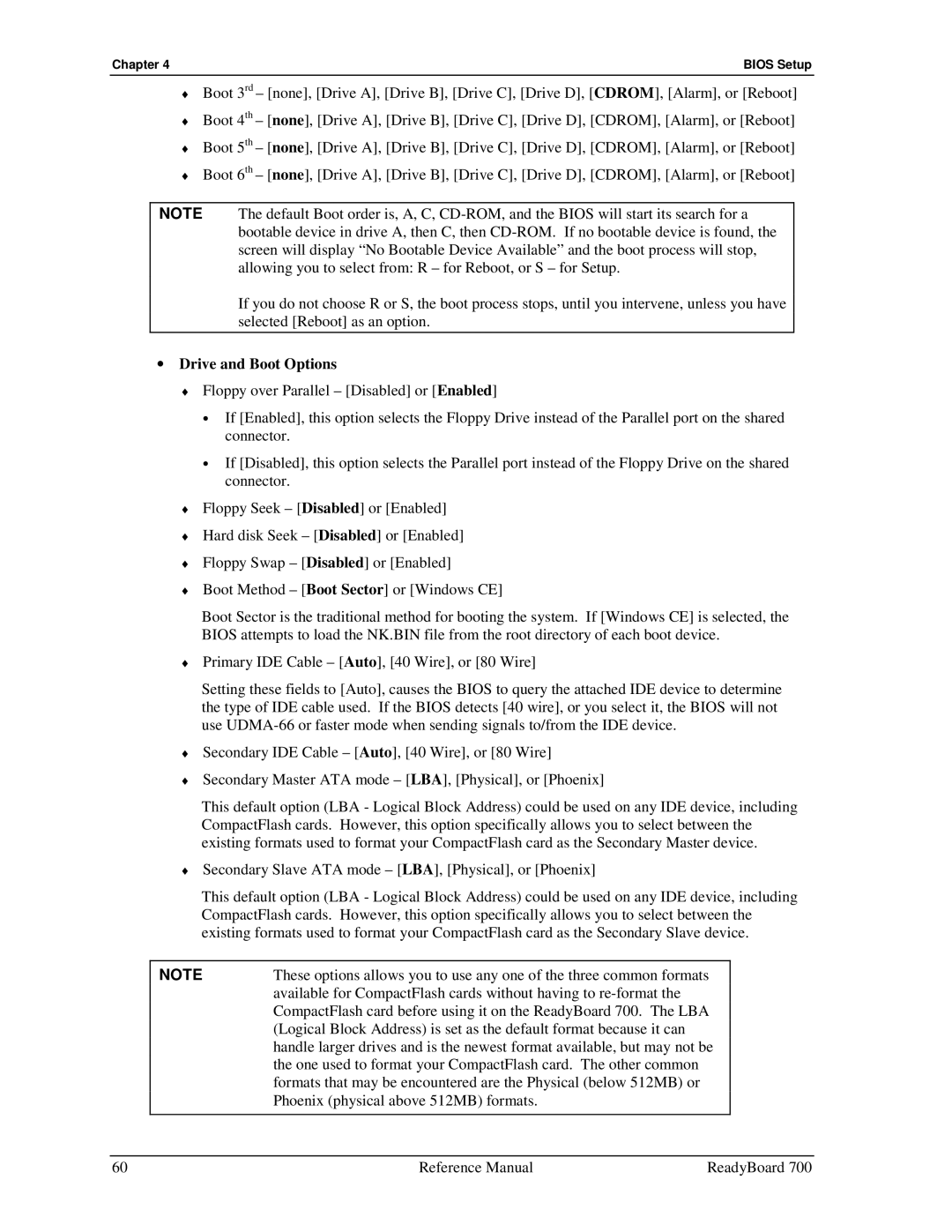
Chapter 4 | BIOS Setup |
♦Boot 3rd – [none], [Drive A], [Drive B], [Drive C], [Drive D], [CDROM], [Alarm], or [Reboot]
♦Boot 4th – [none], [Drive A], [Drive B], [Drive C], [Drive D], [CDROM], [Alarm], or [Reboot]
♦Boot 5th – [none], [Drive A], [Drive B], [Drive C], [Drive D], [CDROM], [Alarm], or [Reboot]
♦Boot 6th – [none], [Drive A], [Drive B], [Drive C], [Drive D], [CDROM], [Alarm], or [Reboot]
NOTE The default Boot order is, A, C,
If you do not choose R or S, the boot process stops, until you intervene, unless you have selected [Reboot] as an option.
•Drive and Boot Options
♦Floppy over Parallel – [Disabled] or [Enabled]
•If [Enabled], this option selects the Floppy Drive instead of the Parallel port on the shared connector.
•If [Disabled], this option selects the Parallel port instead of the Floppy Drive on the shared connector.
♦Floppy Seek – [Disabled] or [Enabled]
♦Hard disk Seek – [Disabled] or [Enabled]
♦Floppy Swap – [Disabled] or [Enabled]
♦Boot Method – [Boot Sector] or [Windows CE]
Boot Sector is the traditional method for booting the system. If [Windows CE] is selected, the BIOS attempts to load the NK.BIN file from the root directory of each boot device.
♦Primary IDE Cable – [Auto], [40 Wire], or [80 Wire]
Setting these fields to [Auto], causes the BIOS to query the attached IDE device to determine the type of IDE cable used. If the BIOS detects [40 wire], or you select it, the BIOS will not use
♦Secondary IDE Cable – [Auto], [40 Wire], or [80 Wire]
♦Secondary Master ATA mode – [LBA], [Physical], or [Phoenix]
This default option (LBA - Logical Block Address) could be used on any IDE device, including CompactFlash cards. However, this option specifically allows you to select between the existing formats used to format your CompactFlash card as the Secondary Master device.
♦Secondary Slave ATA mode – [LBA], [Physical], or [Phoenix]
This default option (LBA - Logical Block Address) could be used on any IDE device, including CompactFlash cards. However, this option specifically allows you to select between the existing formats used to format your CompactFlash card as the Secondary Slave device.
NOTE | These options allows you to use any one of the three common formats |
| available for CompactFlash cards without having to |
| CompactFlash card before using it on the ReadyBoard 700. The LBA |
| (Logical Block Address) is set as the default format because it can |
| handle larger drives and is the newest format available, but may not be |
| the one used to format your CompactFlash card. The other common |
| formats that may be encountered are the Physical (below 512MB) or |
| Phoenix (physical above 512MB) formats. |
|
|
60 | Reference Manual | ReadyBoard 700 |
